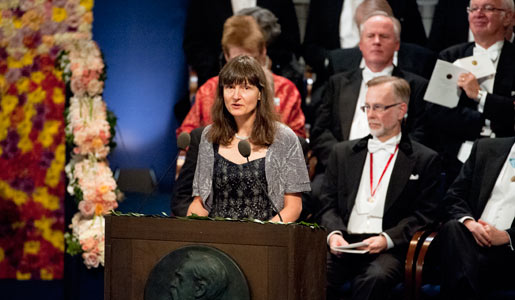Award ceremony speech
English
Presentation Speech by Professor Sara Snogerup Linse, Member of the Royal Swedish Academy of Sciences; Member of the Nobel Committee for Chemistry, 10 December 2012.

Professor Sara Snogerup Linse delivering the Presentation Speech for the 2012 Nobel Prize in Chemistry at the Stockholm Concert Hall.
Copyright © Nobel Media AB 2012
Photo: Alex Ljungdahl
Like ingenious receivers, the G-protein-coupled receptors provide cells with sensibility. The receivers sense the composition of their surroundings. Based on what they find, different messages are delivered to the inside of the cell. Robert Lefkowitz and Brian Kobilka have shown us what these fantastic receptors look like, how they are built, how they function and how they are regulated in finest molecular detail. They have discovered that a whole family of receptors are built and act in a similar manner. Through evolution, these receptors have been refined to sense and distinguish almost a thousand signals. This lets us react to the adrenaline that rushes in our blood-stream when we get scared, the exciting scents and aromas that we will meet in the Blue Hall or the beautiful creations that already surround us. The joy we feel right now is indeed also due to G-protein-coupled receptors. The fluid surrounding our cells is filled with signalling substances. The receptors capture these and create euphoria in our cells.
Today we know the composition and function of many biomolecular systems, for example the ribosome – the protein factory of the cell. In addition, we know quite a bit about the driving forces that let molecules work together in time and space, so that complexes are formed fast enough and survive sufficiently long. But the number of possible combinations is almost infinite. In spite of this, or maybe thanks to this, evolution has given us a multitude of smart solutions for optimal cooperation. Also, because of this, it is difficult to predict what we have not yet observed. We may guess quite well, but still we miss many details and clever connections. When the discovery is there in front of us, with its intricate complexity revealed and simplified, we see and understand. We may even say: Of course! Oh yes! This is the way it must be! But we would never have guessed.
In the fairy-tale, the young dragon tells his friends that he wants to become a discoverer. “Discover what”, one of his friends immediately asks. “Of course I cannot know beforehand”, is the rapid and obvious response. In our own reality, scientists are often asked to tell beforehand what they are going to discover, preferably also by what method and sometimes also when the discovery will be made. Is it surprising that we sometimes wonder what is a fairy-tale and what is reality?
The ingenious creations of nature go far beyond our widest fantasy and imagination. This year’s Nobel Prize in Chemistry is a brilliant example of this. When Robert Lefkowitz and Brian Kobilka entered the lab to investigate the beta-adrenergic receptor, they had no clue what would be revealed during the decades to come. They enjoyed the excitement over the unexpected finding of a family of structurally and functionally related receptors. Perhaps, they were as surprised as we to find that the receptors might be best called by another name.
Great discoveries often happen by serendipity, but by those who are observant and aware enough to reconsider their views. Such awareness stems from the experience and knowledge that arises when effort and time is spent to dig deep into the fundamentals of a scientific question. With great dedication, creativity and patience, Robert Lefkowitz and Brian Kobilka gradually learned to master the receptors. They developed methods to detect and lure them out of their shelters and to study them in almost every possible way. Over the decades they learned in the finest molecular detail how these receptors are built, how they transmit signals over the membrane and how they are regulated. The reward was extensive and rich. Their discoveries are molecular masterpieces in many respects. One of nature’s wonders is now revealed in all its beauty. They have also given us a brilliant masterpiece in the form of powerful methodology and elegant strategies to study receptors of the greatest importance to mankind.
Brian Kobilka and Robert Lefkowitz. Your studies of G-protein-coupled receptors have revealed in the finest molecular detail an amazing signalling mechanism that lets our cells receive information from outside. That is a truly great achievement. On behalf of the Royal Swedish Academy of Sciences I wish to convey our warmest congratulations, and I now ask you to step forward and receive your Prize from the Hands of His Majesty the King.
Nobel Prizes and laureates
Six prizes were awarded for achievements that have conferred the greatest benefit to humankind. The 12 laureates' work and discoveries range from proteins' structures and machine learning to fighting for a world free of nuclear weapons.
See them all presented here.
